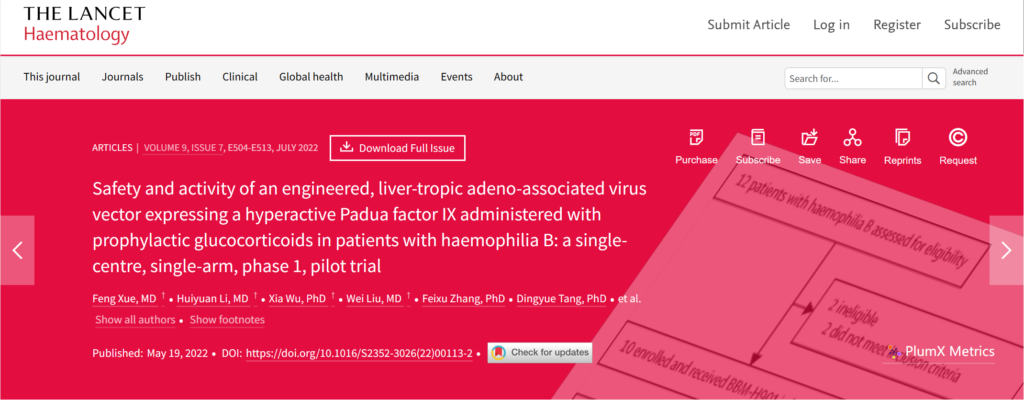In July 2022, a study led by Professor Feng Xue et al. was published in the international academic journal ——Lancet Haematol. The title of the study is "Safety and activity of an engineered, liver-tropic adeno-associated virus vector expressing a hyperactive Padua factor IX administered with prophylactic glucocorticoids in patients with haemophilia B: a single-centre, single-arm, phase 1, pilot trial". This study indicate that BBM-H901 is safe and effective for patients with hemophilia B. Our exploratory single-cell RNA sequencing analysis also suggests that prophylactic glucocorticoid treatment can reduce the baseline levels of APCs, CD4+ T cells, and CD8+ T cells, while promoting Treg activation in patients undergoing gene therapy for hemophilia B.
Hemophilia B is a monogenic inherited bleeding disorder caused by a mutation in the F9 gene, resulting in lifelong excessive bleeding, typically occurring in joints and muscles, leading to arthropathy. Gene replacement therapy using adeno-associated virus (AAV) vectors has long been pursued and has undergone numerous human clinical trials. To increase the success rate of gene therapy for hemophilia B, the use of liver-targeted AAV capsids to improve delivery efficiency and reduce immunogenicity has become desirable. BBM-H901 is a novel vector comprised of an engineered liver-targeted AAV capsid (AAV843), a synthesized liver-specific promoter, and a CpG-reduced FIX Padua encoding sequence packaged in an AAV particle as a double-stranded AAV genome. We initiated a phase 1 trial using BBM-H901 for F9 gene transfer. Unlike all previous studies in this setting, exploratory prophylactic glucocorticoid treatment one week before AAV vector infusion was investigated to reduce potential immune responses against the AAV capsid.
This is a single-center, single-arm, phase 1 pilot trial aimed at evaluating the safety and efficacy of a single intravenous infusion of BBM-H901. We enrolled adult patients with hemophilia B aged 18 years and older at the Institute of Hematology, Blood Diseases Hospital, Chinese Academy of Medical Sciences (Tianjin, China), who met the following inclusion criteria: baseline FIX:C levels less than 2 IU/dL, a history of at least 100 exposures to FIX concentrates, no history of FIX inhibitors, low titers of neutralizing antibodies against the BBM-H901 capsid (≤1:4), and acceptable laboratory values (hemoglobin ≥11 g/dL, platelets ≥100,000 cells/μL, AST, ALT, and alkaline phosphatase levels not exceeding two times the upper limit of normal, bilirubin not exceeding three times the upper limit of normal, and creatinine ≤2.0 mg/dL).
The primary endpoint was the safety of BBM-901, including incidence of treatment-related adverse events within 1 year after infusion, changes in ALT and AST, and development of antibodies against the AAV843 capsid. The secondary endpoint was the vector-derived FIX:C, measured by one-stage aPTT method (appendix p 2). Exploratory prespecified endpoints were residual vector genomes in body fluids (specifically, vector shedding in blood, saliva, urine, and semen, measured with qPCR), change in number of target joints, annualised bleeding rate (number of bleeding events per year), annualised number of FIX infusion 1 year before and after vector infusion, and immune status change after glucocorticoid treatment.
In this phase 1 study, we evaluated the tolerability, safety, and activity of BBM-901, an AAV-based gene therapy vector, in ten patients with hemophilia B in China. Throughout the study, no grade 3–4 adverse events were observed, and adverse events related to BBM-H901 (including grade 2 pyrexia, elevation of ALT and AST) occurred only in two participants and were resolved after short interventions.
We also found that there were no inhibitors against FIX Padua in our Chinese hemophilia B patients, which is also an ideal safety characteristic. Although many previous liver-targeted gene therapies have shown detectable vector-derived FIX:C and a reduction in bleeding rates and the need for FIX concentrates, the main challenge for safety and activity is the T cell immune response against the AAV capsid proteins in the transduced hepatocytes or CpG oligonucleotides. The vector components used in this study were optimized with CpG oligonucleotide ablation, thus avoiding immune reactions against CpG. Asymptomatic transaminitis often triggers a decline or even complete loss of vector-derived FIX expression levels. Some participants retained gene expression when treated with glucocorticoids, while others did not. All previous studies used glucocorticoids after vector infusion either as prophylaxis or treatment in response to transaminase elevation. We instead initiated prednisone prophylaxis 7 days before AAV injection. Glucocorticoids were gradually tapered off in about 8 weeks. We believe that, in addition to reducing T cell immune responses before AAV vector injection, prophylactic glucocorticoid treatment may potentially protect participants from delayed discovery of liver enzyme elevation induced by cellular immune responses against transduced hepatocytes after gene therapy. If participants missed regular visits for any reason (such as travel restrictions), they might be at risk of asymptomatic ALT and AST elevation without knowing it, thus delaying the initiation of glucocorticoid treatment. We observed some adverse events related to glucocorticoid prophylaxis, but all were mild at grade 1 or 2.
In summary, our results indicate that BBM-H901 is safe and effective for patients with hemophilia B. Our exploratory single-cell RNA sequencing analysis also suggests that prophylactic glucocorticoid treatment can reduce the baseline levels of APCs, CD4+ T cells, and CD8+ T cells, while promoting Treg activation in patients undergoing gene therapy for hemophilia B. Therefore, this prophylactic glucocorticoid treatment regimen may be helpful in attenuating immune responses in other gene therapies for hemophilia patients.
Related recommendations:Gene Therapy Milestone: Elevated FIX Levels Achieved in Chinese Hemophilia B Patients


